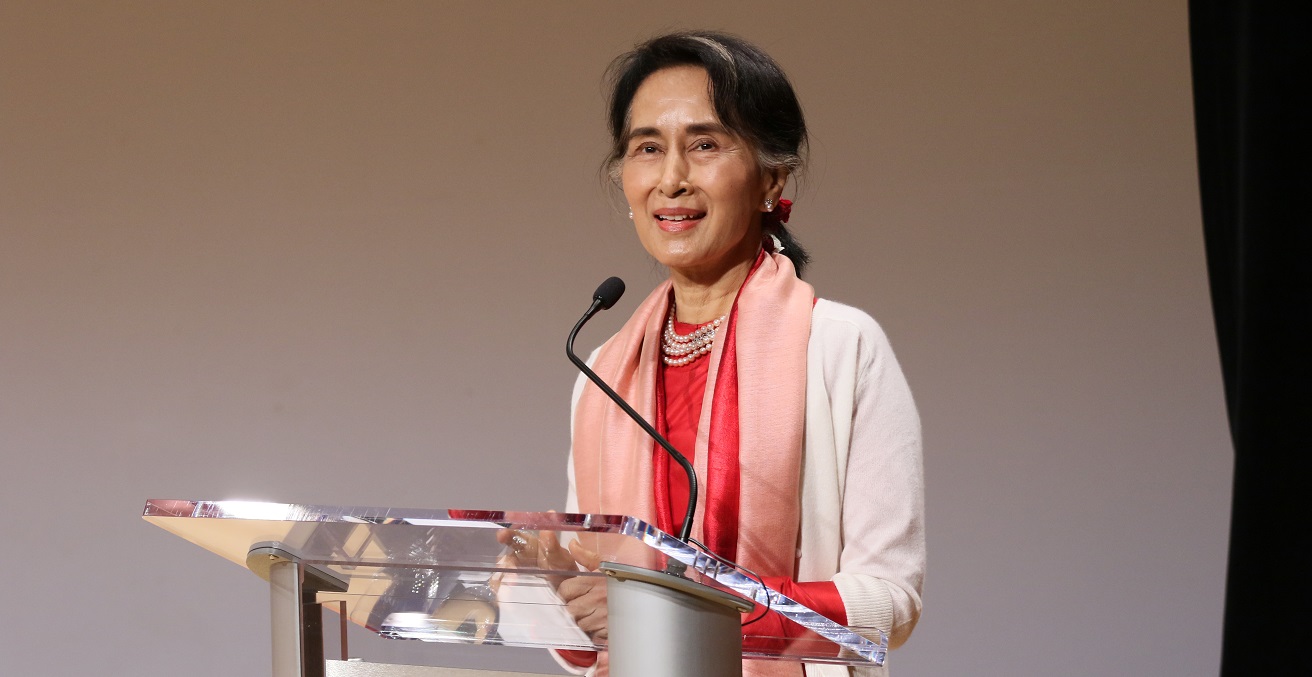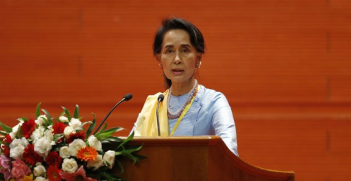What Does Aung San Suu Kyi's Re-Election Mean For India?

The recent reelection of Aung San Suu Kyi has offers ample opportunities as well as challenges for neighbouring India. These include several connectivity projects nearing completion, China’s looming economic presence, and troubled land borders.
In October 2020, New Delhi gifted a Kilo-class diesel submarine to its eastern neighbour Myanmar, a month after Indian Foreign Secretary Harsh Vardhan Shringla and Chief of Army Staff General MM Naravane’s visit to Naypyidaw. India’s move coincided with Myanmar’s national elections, which saw the reelection of The National League for Democracy (NLD), under the leadership of Aung San Suu Kyi. The elections were conducted amidst a surge of COVID-19 cases, the assertive posture of the military in state affairs, and the re-emergence of Buddhist nationalism over the last five years. Election results show a quest for democratic aspiration amongst the people, even after incumbent NLD-led Suu Kyi’s government faced criticism on control over the free press and military crackdown against Rohingya Muslims.
India’s strategic ambitions and challenges
Myanmar is a strategic catalyst in India’s outreach to Southeast Asia. For multiple reasons, it is central to India’s Look East Policy, as well as its subsequent Act East Policy. India and Myanmar share a 1643-kilometre-long land border reaching from Bangladesh to China. India’s north-eastern states, including Manipur, Mizoram, Arunachal Pradesh, and Nagaland, are geographically proximal to Myanmar. For India, it is vital to transform the northeast to a land-linked region with Myanmar as a gateway to greater Asian integration.
To effect this transformation, India has created numerous connectivity projects with Myanmar. First conceived in the 2000s, these connectivity projects faced hurdles in completion owing to lack of funding, problems in land acquisition, and threats from armed rebel groups. Nevertheless, India has executed the Kaladan Multi-Modal Transit Transport Project, which connects the Indian state of Mizoram to the Sittwe port in Myanmar and is expected to be completed by 2021, as well as the India-Myanmar-Thailand (IMT) trilateral highway. Both of these projects will boost trade and commerce in the ASEAN-India Free Trade Area. Myanmar is also important to India in countering the cross-border armed insurgencies sponsored by separatist organisations like the National Socialist Council of Nagaland and the United Liberation Front of Assam, which possess hideouts in the hilly areas of Myanmar’s Sagaing region.
The immediate challenge for India after the NLD’s reelection is balancing China’s strategic depth in Myanmar. In 2018, China signed a multi-billion dollar deal to develop a deep-water port in Kyaukpyu, situated on the western coast of Myanmar. This port holds special significance due to its proximity to India’s strategic islands. As well, Kyaukpyu is the terminus of a $1.5 billion oil and gas pipeline which connects China’s Yunnan province to the Indian Ocean. This pipeline will eventually bypass China’s overreliance on the vulnerable Malacca Strait region for its energy supplies.
To balance the increasing presence of China, India is employing multiple forums for engaging Myanmar. The latest forum was developed in Shringla and Naravane’s recent visit to Myanmar, which inaugurated a high-tech IT training centre in Myitkyina, a facility with geopolitical juxtaposition to Yunnan and India’s northeast.
Myanmar’s patchy democratic transition
In the recent election, Myanmar’s ruling party, the NLD, won a landslide victory, securing more than 80 percent of the seats where elections were conducted. Since 2008, the military-drafted constitution has demanded 25 percent of unelected seats must be reserved for the military in the upper and lower houses of parliament. However, the popular mandate secured in Suu Kyi’s recent victory offers her a greater autonomy in decision-making in both houses of parliament.
Even though Suu Kyi is championed as the face of human rights, her popularity on the international stage is counteracted due to her silent support of military actions against the Indo-Aryan ethnic group, the Rohingya. As opposed to previous elections, the 2020 election in Myanmar saw the Rohingya people excluded from the voting process due to security concerns. Suu Kyi was seen to have defended the army at the International Court of Justice against a charge alleging commission of a campaign of violence against the Rohingya people in Rakhine State. This alleged commission of violence resulted in the creation of more than 740,000 refugees.
India, the world’s largest democracy, always shied away from taking a position on Myanmar military’s violent treatment against the Rohingya. Here, India, as a regional power, should promote a political stand with the NLD government to allow independent probes into persecutions and ensure fair treatment of the Rohingya. In absentia, the refugee inflow will have implications on India’s national security.
Hope for freedom of the press in Myanmar could also be assessed as short-lived under the NLD government. By 2018, 44 journalists in Myanmar had faced trial since the NLD took power.
Elections and the future of India-Myanmar ties
The election results indicate that India should take a balanced approach towards the NLD government and the Tatmadaw forces. India and Myanmar have perceived a shared terrorist threat from the Arakan Army and the Arakan Rohingyan Salvation Army, which are tied to military support from China.
The Chinese presence in Myanmar is a double-edged sword. On the one hand, China provides arms, ammunition, and investments to the government. On the other, China also offers weapons to rebel separatist groups within Myanmar. Recently, the Thai military seized a consignment of Chinese-made weapons which were to be delivered to the Arakan Army. Last year, the Arakan Army attacked and abducted five Indian nationals working for the Kaladan Multi-Modal Project.
On this basis, India and Myanmar share converging security interests in securing the borders. To resolve the common terrorist threat and greater regional integration to Southeast Asia, India’s outreach to the Myanmar government is crucial. In order to entrench India’s discursive power on Myanmar, it must promote closer economic ties by encouraging investments and trade. Despite sharing a large border, India-Myanmar bilateral trade stands at $1.6 billion. As well, India is the 11th largest foreign investor. However, China is miles ahead in terms of bilateral trade with Myanmar, accounting for $17.7 billion. India should take measures to fast-track the completion of connectivity projects to Myanmar as this will give a fresh impetus to bolster economic relations.
Conclusion
The election predicates an easy walkover for Beijing to advance its looming economic presence over Myanmar’s “quasi-democracy” sponsored by its balanced civil-military administration. However, India’s recent high-profile visit to Myanmar and delivery of COVID-19 aid packages and military deals reiterates the geopolitical significance of the country which connects South Asia to Southeast Asia. As China makes its foothold stronger with infrastructural projects and arms sales, India needs to leverage its geographical proximity, securitisation of borders, and soft power potentials to balance the dragon in its backyard.
Kannan Nair is a research fellow at the Eurasian Research and Analysis Institute. He was a former advocate for the Global Schools Program and is the Global Youth Ambassador for TheirWorld.
This article is published under a Creative Commons Licence and may be republished with attribution.





